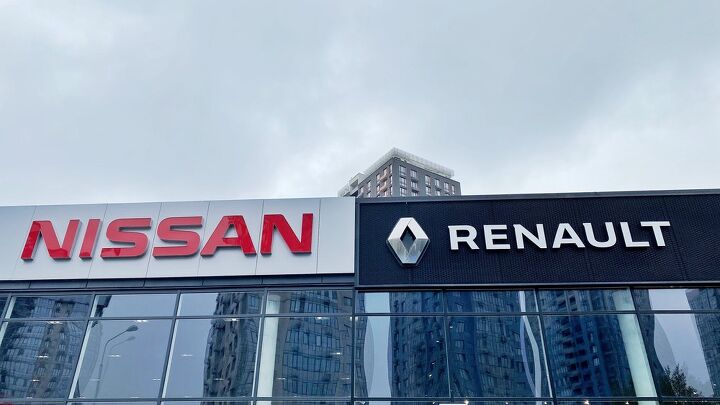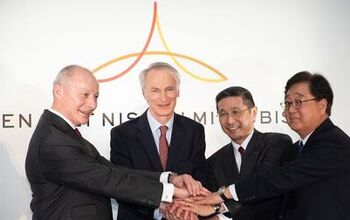Renault–Nissan–Mitsubishi Alliance Being Overhauled

The strategic partnership between France’s Renault and Japan’s Nissan has been a tenuous alliance throughout most of its history. However, the duo is attempting – once again – to tweak the nature of their complicated relationship in the hopes it produces better cooperation and reduced animosity.
While the stated goal was to increase economies of scale for both brands without either having to lose their autonomy, many noted that Nissan was in rough shape by 1999 and was running out of options. This laid the groundwork for nearly two decades of clandestine infighting between management and foreshadowed the scandal surrounding Carlos Ghosn – who became the CEO of both companies, often being credited as the man who saved Nissan – and several other high-ranking executives.
In May of 1999, Renault purchased a 36.8-percent stake in Nissan. This effectively saved the Japanese company’s bacon but the following years resulted in a comeback story to be envied. Nissan was quickly in a position to repay the French brand by purchasing a 15-percent stake and became the larger brand due to its sizable volume in Asia and North America. It wasn’t long before Nissan staffers were asking themselves why Renault, and thereby the French government (being the automaker’s largest shareholder), had voting rights they lacked. After all, Nissan was the larger company, and the size gap only appeared to be widening.
Renault’s influence became a source of resentment among many Nissan executives and a sizable contingent of its workforce. Japan is a country that’s pretty serious about its culture and has historically gone out of its way to protect or isolate itself from outside influence when it doesn’t appear to offer a tangible advantage. Meanwhile, the French government was seeking to expand its own influence over Renault by increasing its stake. This rubbed both companies the wrong way and resulted in a short-lived and semi-unified opposition to state influence.
While there’s certainly a lot we’re not covering, the important thing to remember is that neither company was doing all that well by 2018. However, Nissan (which had purchased a controlling stake in Mitsubishi two years earlier) had further to fall now that its booming volume had started to decline. Corporate infighting had likewise resumed and there was a surprise announcement in November that CEO Carlos Ghosn (who chaired the alliance) had been detained by Japanese authorities.
This was the tipping point.
Suspicions abounded. Many claimed this was an industrial coup, with there being a wealth of evidence to support those claims. Numerous high-ranking executives were likewise implicated in some of the financial crimes Ghosn was likewise being accused of. Ghosn had made a lot of enemies and defied Japanese tradition by snubbing promotional schemes based on seniority. He was more willing to hire outsiders into high-level positions and made a surplus of enemies as a result. While imprisoned, he alleged that these things had ensured he would not get a fair trial in Japan due to plans that he sought to further integrate Renault and Nissan. He likewise cited constantly evolving charges and a lack of cooperation from Japanese authorities.
With bail being repeatedly rejected and new claims from Renault and the French government that some of Ghosn’s money may not have been acquired legally, the man was smuggled out of the country and into Lebanon where he now lives as a fugitive.
The recent announcement that the companies have been reconsidering the relationship has been a long time coming. There have been numerous attempts to rejigger the partnership into something a bit more amicable. But it’s frequently been undermined by competing agendas. Under the revised agreement, both automakers will hold a 15-percent stake in the other. Additionally, they’ll have to match investments into Latin America, India, and Europe – regardless of which brand is more dominant in those markets. Nissan is also supposed to be investing a meaningful amount of itself into Renault’s EV and software startup Ampere.
The companies have released a joint statement acknowledging the changes. But nothing has been set in stone just yet. As things currently stand, they’ve only agreed on a basic framework for re-balancing their relationship. Finalization of the deal is expected anytime now. But there is a chance that things could still fall apart.
Renault arguably has the most to lose here. The company is reducing its stake to improve the relationship and will transfer 28.4 percent of its stake to a French trust, neutralizing its voting rights in most instances. While it can still profit from the sale of those shares, its influence over Nissan has been scaled back immensely. Meanwhile, Nissan and Mitsubishi will be getting access to Renault's new EV tech and will presumably see more autonomy than it has in years. There’s also supposed to be collaboration on numerous programs focusing on market penetration and some jointly developed vehicles.
The agreement is expected to see board approval with a formal announcement rumored to take place by February 6th.
[Image: Yuliia Lisiana/Shutterstock]
Become a TTAC insider. Get the latest news, features, TTAC takes, and everything else that gets to the truth about cars first by subscribing to our newsletter.

A staunch consumer advocate tracking industry trends and regulation. Before joining TTAC, Matt spent a decade working for marketing and research firms based in NYC. Clients included several of the world’s largest automakers, global tire brands, and aftermarket part suppliers. Dissatisfied with the corporate world and resentful of having to wear suits everyday, he pivoted to writing about cars. Since then, that man has become an ardent supporter of the right-to-repair movement, been interviewed on the auto industry by national radio broadcasts, driven more rental cars than anyone ever should, participated in amateur rallying events, and received the requisite minimum training as sanctioned by the SCCA. Handy with a wrench, Matt grew up surrounded by Detroit auto workers and managed to get a pizza delivery job before he was legally eligible. He later found himself driving box trucks through Manhattan, guaranteeing future sympathy for actual truckers. He continues to conduct research pertaining to the automotive sector as an independent contractor and has since moved back to his native Michigan, closer to where the cars are born. A contrarian, Matt claims to prefer understeer — stating that front and all-wheel drive vehicles cater best to his driving style.
More by Matt Posky
Latest Car Reviews
Read moreLatest Product Reviews
Read moreRecent Comments
- EBFlex Smart people
- Wjtinfwb "Rovelo" tires? Good to see TTAC is not above the shameless commercial endorsement of unknown product like it's bigger print competitors.
- Wjtinfwb Looks in decent nick for a Junkyard car. Other than the interior being partially gutted for some trim pieces, you could probably drive it out of the junkyard. Maybe a transmission issue and the cars value precluded a $2k or more fix? J cars were pathetic when introduced in '82 and never really got any better. But GM did sort out most of the reliability issues and with a modicum of maintenance these would run a long time if you could stand the boredom. Guess this owner couldn't.
- GS340Pete I see a lot of these on the road. I can't remember the last time I saw one on my local Chevy dealership's lot. They've never in my memory had a few lined up with balloons. Short sighted to kill it off? Perhaps. But I certainly think the rows of $65k and up trucks is short sighted. That's going to bite soon. Looks like they're piling up already.And what about the Trax? Malibu or Trax? Gotta be honest, I'd pick the Trax.Although it should have 50 more HP IMHO. And why are so many preaching doom about the 'wet belt' engine?RIP, Malibu. Ride the highway in the sky with the Impala (talk about short sighted.)
- ToolGuy GM didn't care about these and you shouldn't either. 😉


































Comments
Join the conversation
They keep using the word “alliance” for this mash-up. So as usual, I ask: what will they do for an encore?! (Maybe heater cores that don’t explode, bathing the front passenger’s legs in hot coolant, would be a start!)
I don't understand how Mitsubishi is still hanging on. They have like 3 models.